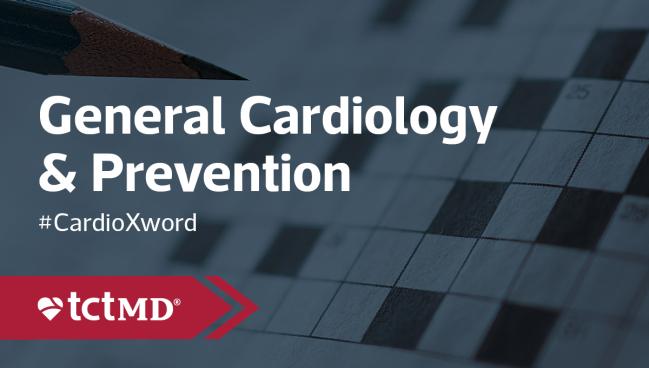Top General Cardiology and Prevention News of 2024
The year had a lot to offer, from advanced therapies aimed at Lp(a), GLP-1, and other targets, to support for simpler strategies.

Multiple reports highlighted the work being done to develop therapies to lower Lp(a) levels (LPA; 17 Across), which are largely determined by genetics but can vary over time for some individuals. Two phase II trials released data showing the promise of Lp(a)-lowering therapies—the oral agent muvalaplin (Eli Lilly) in KRAKEN, as well as the small interfering RNA (siRNA) zerlasiran (Silence Therapeutics) in ALPACAR-360.
For GLP-1, the FLOW trial (FLOW; 41 Across) made the case that semaglutide (Ozempic or Wegovy; Novo Nordisk) not only leads to weight loss, reduces cardiovascular events, improves heart failure symptoms, and controls blood sugar in various patient groups, but also protects against major kidney disease events specifically in people with type 2 diabetes and chronic kidney disease. Tirzepatide (Zepbound or Mounjaro; Eli Lilly), which targets GLP-1 plus glucose-dependent insulinotropic polypeptide (GIP), also continued to make waves. The SUMMIT trial showed the drug’s positive impact in patients with obesity-related heart failure with preserved ejection fraction (HFpEF), while other data pointed to its effects on blood pressure and showed its advantage over semaglutide as a potent tool for weight loss.
However, the jury’s still out on whether the pricey GLP-1 receptor agonists save healthcare dollars and whether better reimbursement is on the way. Something to look forward to in the coming years, hopefully, are oral versions of these currently injectable-only drugs.
One headline-grabbing study this year drew eyes to a ubiquitous risk—plastic (PLASTIC; 32 Across)—that might one day serve as a target in disease prevention. Researchers reported the disturbing finding that some patients with carotid stenosis have evidence of microscopic particles from environmental plastics in their atherosclerotic plaque. Not only that, but these individuals are more likely to experience an adverse CV event than those without the particles.
Getting back to prevention basics, though, this year the European Society of Cardiology issued new guidelines for hypertension that shifted treatment targets lower (BP; 36 Across), coming more in line with the 2017 US recommendations. Additionally, multiple studies continued to validate the new PREVENT tool’s accuracy at predicting risk (PREVENT; 18 Down), with implications for primary prevention. The PREVENT equations capture a spectrum of cardiovascular, kidney, and metabolic risk, and they also provide estimates of the 10- and 30-year risks of MI, stroke, and heart failure in people as young as 30 years old.
While lifestyle changes and medical therapy can help curb those long-term risks, some attempts at prevention may be misguided—evidence continues to grow that sugar alcohols, including the low-calorie xylitol (LOWCAL; 28 Across), are linked to higher CV risk.
And finally, for patients who find themselves in the cath lab despite their efforts at prevention, there’s some good news: even more data now confirm that allowing patients to eat (FOOD; 51 Down) before a cardiac catheterization does no harm, and may offer benefits, compared with the standard practice of nothing by mouth after midnight.
Advanced Therapies, but Basics, Too
Eugenia Gianos, MD (Northwell Health, New York, NY), chair of the American College of Cardiology’s Prevention of Cardiovascular Disease Council, spoke with TCTMD to highlight some of the big trends of 2024.
Among the hottest topics, she said, is cardiometabolic health.
She pointed, in particular, to the aforementioned SUMMIT trial in HFpEF patients showing a nearly 40% reduction in cardiovascular mortality and worsening heart failure events over roughly 2 years with tirzepatide versus placebo. “We just haven’t had much in the realm of heart failure with preserved ejection fraction that improves outcomes,” she said, describing SUMMIT as a “big, landmark trial.” Substudies from the trial showed other positive signs as well, with less epicardial fat and reduced high-sensitivity C-reactive protein in patients who received the GLP-1/GIP drug.
From the hypertension world, there also were high notes.
Gianos highlighted the KARDIA-2 trial showing that zilebesiran (Alnylam Pharmaceuticals), a twice-yearly injection that blocks production of angiotensinogen, reduces systolic BP when taken on top of other common medications. “It’s actually one of the first injectable blood pressure-lowering drugs . . . [and] is a cool new thing for the future,” she noted. Moreover, the siRNA joins the list of similar therapies that have shown positive results in reducing Lp(a), LDL, and triglycerides.
The recently presented BPROAD trial, meanwhile, made the case for intensively treating systolic blood pressure to below 120 mm Hg in patients with type 2 diabetes and hypertension compared with the standard protocol of less than 140 mm Hg. “There’s been a lot of controversy in this area,” said Gianos, with discordant findings from the 2010 ACCORD and 2015 SPRINT trials. “Just the fact that now this trial shows benefit makes us rethink where we want to get people’s blood pressures to.”
She also highlighted the BROOKLYN trial for its results showing that the investigational CETP inhibitor obicetrapib (NewAmsterdam Pharma)—a drug initially developed to raise HDL cholesterol levels—reduces LDL in patients with heterozygous familial hypercholesterolemia. “It has tremendous promise,” she said.
As for implementation, a high note for Gianos in 2024 was the TACTiC trial, in which an online app enabled most participants to appropriately select themselves as candidates for over-the-counter statin therapy. “There’s a lot of stigma with statins” that can make patients reluctant to take them, said Gianos. “Getting more patients in the population to be on even basic therapies like that would be a huge deal, because really we’re doing very poorly at [this]. Forget about all these advanced therapies that we’re talking about: most people [aren’t even] on a statin.”
Similarly, the concept of “food is medicine” might move the needle as a relatively simple and affordable tool for prevention, Gianos noted.
It’s also key that advanced therapies like GLP-1 receptor agonists need to be paired with other long-standing strategies, she stressed. “The future for these GLP-1s is tremendously bright, but I think it is a major responsibility of our medical community to make sure that on a population health level, we are implementing these with appropriate lifestyle therapy. Otherwise, truthfully, for many of these patients, we’re actually not doing them a service.”
Caitlin E. Cox is News Editor of TCTMD and Associate Director, Editorial Content at the Cardiovascular Research Foundation. She produces the…
Read Full BioDisclosures
- Gianos reports no relevant conflicts of interest.





Comments